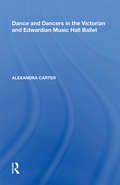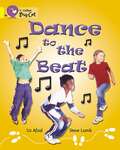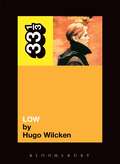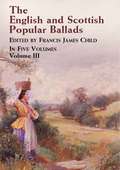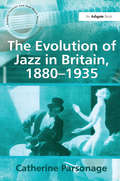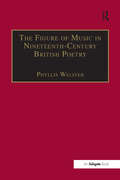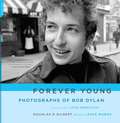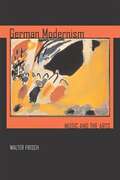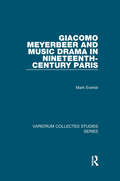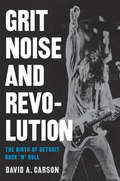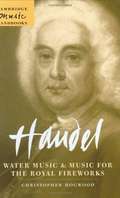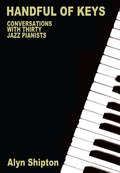- Table View
- List View
Da Capo Best Music Writing 2005: The Year's Finest Writing on Rock, Hip-Hop, Jazz, Pop, Country, & More
by JT LeRoyDa Capo Best Music Writing has become one of the most eagerly awaited annuals of them all. Celebrating the year in music writing by gathering a rich array of essays, missives, and musings on every style of music from rock to hip-hop to R&B to jazz to pop to blues and more, it is essential reading for anyone who loves great music and accomplished writing. Scribes of every imaginable sort-novelists, poets, journalists, musicians-are gathered to create a multi-voiced snapshot of the year in music writing that, like the music it illuminates, is every bit as thrilling as it is riveting.Past writers have included:Elizabeth MEndez Berry * Ta-Nehisi Coates * Michael Corcoran * Robbie Fulks * Michaelangelo Matos * Alex Ross * Roni Sarig * Joel Selvin * Tour8E * Lynn Hirschberg * Chuck Klosterman * Elizabeth Gilbert * Jay McInerney * Elvis Costello * Susan Orlean * Jonathan Lethem * David Rakoff * Mike Doughty * Lorraine Ali * Greil Marcus * Richard Meltzer * Robert Gordon * Sarah Vowell * Nick Tosches * Anthony DeCurtis * William Gay * Whitney Balliett * Lester Bangs * Rosanne Cash * Eddie Dean * Selwyn Seyfu Hinds * Kate Sullivan * Alec Wilkinson * David Hadju * Lenny Kaye * The Onion * Mark Jacobson * Gary Giddins * John Leland * Luc Sante * Monica Kendrick * Kalefa Sanneh
Da Capo Best Music Writing 2005: The Year's Finest Writing on Rock, Hip-Hop, Jazz, Pop, Country, & More
by JT LeRoyDa Capo Best Music Writing has become one of the most eagerly awaited annuals of them all. Celebrating the year in music writing by gathering a rich array of essays, missives, and musings on every style of music from rock to hip-hop to R&B to jazz to pop to blues and more, it is essential reading for anyone who loves great music and accomplished writing. Scribes of every imaginable sort-novelists, poets, journalists, musicians-are gathered to create a multi-voiced snapshot of the year in music writing that, like the music it illuminates, is every bit as thrilling as it is riveting.Past writers have included:Elizabeth MEndez Berry * Ta-Nehisi Coates * Michael Corcoran * Robbie Fulks * Michaelangelo Matos * Alex Ross * Roni Sarig * Joel Selvin * Tour8E * Lynn Hirschberg * Chuck Klosterman * Elizabeth Gilbert * Jay McInerney * Elvis Costello * Susan Orlean * Jonathan Lethem * David Rakoff * Mike Doughty * Lorraine Ali * Greil Marcus * Richard Meltzer * Robert Gordon * Sarah Vowell * Nick Tosches * Anthony DeCurtis * William Gay * Whitney Balliett * Lester Bangs * Rosanne Cash * Eddie Dean * Selwyn Seyfu Hinds * Kate Sullivan * Alec Wilkinson * David Hadju * Lenny Kaye * The Onion * Mark Jacobson * Gary Giddins * John Leland * Luc Sante * Monica Kendrick * Kalefa Sanneh
Dance and Dancers in the Victorian and Edwardian Music Hall Ballet
by Alexandra CarterFirst published in 2005. The Victorian and Edwardian music hall ballet has been a neglected facet of dance historiography, falling prey principally to the misguided assumption that any ballet not performed at the Opera House or 'legitimate' theatre necessarily meant it was of low cultural and artistic merit. Here Alexandra Carter identifies the traditional marginalization of the working class female participants in ballet historiography, and moves on to reinstate the 'lost' period of the music hall ballet and to apply a critical account of that period. Carter examines the working conditions of the dancers, the identities and professional lives of the ballet girls and the ways in which the ballet of the music hall embodied the sexual psyche of the period, particularly in its representations of the ballet girl and the ballerina. By drawing on newspapers, journals, theatre programmes, contemporary fiction, poetry and autobiography, Carter firmly locates the period in its social, economic and artistic context. The book culminates in the argument that there are direct links between the music hall ballet and what has been termed the 'birth' of British ballet in the 1930s; a link so long ignored by dance historians. This work will appeal not only to those interested in nineteenth century studies, but also to those working in the fields of dance studies, gender studies, cultural studies and the performing arts.
Dance and Dancers in the Victorian and Edwardian Music Hall Ballet
by Alexandra CarterFirst published in 2005. The Victorian and Edwardian music hall ballet has been a neglected facet of dance historiography, falling prey principally to the misguided assumption that any ballet not performed at the Opera House or 'legitimate' theatre necessarily meant it was of low cultural and artistic merit. Here Alexandra Carter identifies the traditional marginalization of the working class female participants in ballet historiography, and moves on to reinstate the 'lost' period of the music hall ballet and to apply a critical account of that period. Carter examines the working conditions of the dancers, the identities and professional lives of the ballet girls and the ways in which the ballet of the music hall embodied the sexual psyche of the period, particularly in its representations of the ballet girl and the ballerina. By drawing on newspapers, journals, theatre programmes, contemporary fiction, poetry and autobiography, Carter firmly locates the period in its social, economic and artistic context. The book culminates in the argument that there are direct links between the music hall ballet and what has been termed the 'birth' of British ballet in the 1930s; a link so long ignored by dance historians. This work will appeal not only to those interested in nineteenth century studies, but also to those working in the fields of dance studies, gender studies, cultural studies and the performing arts.
Dance To The Beat: Band 03/yellow (Collins Big Cat Ser.)
by Uz Afzal Steve Lumb Cliff Moon Collins Big CatThe Dances of Shakespeare
by Jim HoskinsFirst Published in 2005. Routledge is an imprint of Taylor & Francis, an informa company.
The Dances of Shakespeare
by Jim HoskinsFirst Published in 2005. Routledge is an imprint of Taylor & Francis, an informa company.
David Bowie's Low (33 1/3)
by Hugo WilckenLos Angeles, 1976. David Bowie is holed up in his Bel-Air mansion, drifting into drug-induced paranoia and confusion. Obsessed with black magic and the Holy Grail, he's built an altar in the living room and keeps his fingernail clippings in the fridge. There are occasional trips out to visit his friend Iggy Pop in a mental institution. His latest album is the cocaine-fuelled Station To Station (Bowie: "I know it was recorded in LA because I read it was"), which welds R&B rhythms to lyrics that mix the occult with a yearning for Europe, after three mad years in the New World.Bowie has long been haunted by the angst-ridden, emotional work of the Die Brucke movement and the Expressionists. Berlin is their spiritual home, and after a chaotic world tour, Bowie adopts this city as his new sanctuary. Immediately he sets to work on Low, his own expressionist mood-piece.
DJ Shadow's Endtroducing (33 1/3)
by Eliot WilderWhat resonated about Endtroducing when it was released in 1996, and what makes it still resonate today, is the way in which it loosens itself from the mooring of the known and sails off into an uncharted territory that seems to exist both in and out of time. Josh Davis is not only a master sampler and turntablist supreme, he is also a serious archeologist with a world-thirsty passion (what Cut Chemist refers to as Josh's "spidey sense") for seeking out, uncovering and then ripping apart the discarded graces of some other generation - that "pile of broken dreams" - and weaving them back together into a tapestry of chronic bleakness and beauty.Over the course of several long conversations with Josh Davis (DJ Shadow), we learn about his early years in California, the friends and mentors who helped him along the way, his relationship with Mo'Wax and James Lavelle, and the genesis and creation of his widely acknowledged masterpiece, Endtroducing.
Dream a Little Dream of Me: The Life of 'Mama' Cass Elliot
by Eddi Fiegel'The greatest white female singer ever' is how Boy George described pop icon Cass Elliot, the sixties diva who was at the epicentre of US popular culture and music during the Californian hippy movement. Hailed as America's answer to the Beatles, the Mamas and the Papas' hits such as 'California Dreamin' and 'Monday Monday' became the soundtrack of a generation. Cass's uniquely emotive voice, charismatic wit and outsized multicoloured kaftans singled her out as a popstar who refused to conform to traditional female stereotypes. When she left the Mamas and the Papas, she immediately had a top ten hit with her debut single, 'Dream a Little Dream of Me' and became the queen on Los Angeles society. Her Beverly Hills villa was the scene of legenday parties, becoming the second home of stars such as Jack Nicholson and Grace Slick, but there was a darker side to her fame - after years of continuous dieting and drug addiction, she died mysteriously in London at the age of 33. Including interviews with Cass's friends and family, co-band members Michelle Phillips and Denny Doherty, and many of the famous names who knew her, this is both an insightful biography of an extraordinary singer, and a fascinating glimpse into free-living, free-loving ideals of the sixties as the optimism of the flower-child generation was crushed by the Vietnam War. 'The product of over 100 interviews and four years of research across three continents, it's a fantastic read that goes way beyond thorough . . . Fiegel's fine, all-encompassing tome restores much of the great woman's dignity' - Mojo
Elliott Smith and the Big Nothing
by Benjamin NugentBest known for his Oscar-nominated song "Miss Misery" from the Good Will Hunting soundtrack, Elliott Smith was catapulted to the status of indie rock star after performing at the 1997 Academy Awards. Some of his albums, XO and Either/Or among them, would become '90s classics, helping to define an understated aesthetic that owed as much to the melodic emphasis of The Beatles as it did to punk. In the afterglow of the success of "Miss Misery," Smith's fame grew--alongside his struggles with depression and substance abuse. First relocating to Brooklyn, and then finally to L.A., he fell into a downward spiral evident to friends and fans alike, even as he continued to write such beautifully realized songs as "Waltz #2" (XO). Drawing on new interviews with those who knew and loved Smith, and focusing on the crucial interplay between Smith's life and music, Ben Nugent compellingly and sympathetically portrays an enormously gifted, yet troubled, artist.
Elvis Costello's Armed Forces (33 1/3)
by Franklin BrunoThirty-Three and a Third is a series of short books about critically acclaimedand much-loved albums of the past 40 years. Over 50,000 copies have been sold!"Passionate, obsessive, and smart." -Nylon"...an inspired new series of short books about beloved works of vinyl." -DetailsFranklin Bruno's writing about music has appeared inthe Village Voice, Salon, LA Weekly, and Best MusicWriting 2003 (Da Capo). He has a Ph.D. in Philosophyfrom UCLA, and his musical projects include Tempting:Jenny Toomey Sings the Songs of Franklin Bruno(Misra) and A Cat May Look At A Queen (AbsolutelyKosher), a solo album. He lives in Los Angeles.
The English and Scottish Popular Ballads, Volume 3
by Francis James ChildPublished between 1882 and 1898, this definitive collection compiles all the extant ballads with all known variants and features Child's commentary for each work. Volume III includes Parts V and VI of the original set — ballads 114–188: "Mary Hamilton," "Flodden Field," "Sir Andrew Barton," and more than 30 ballads about Robin Hood.
The Evolution of Jazz in Britain, 1880-1935
by Catherine Tackley Parsonage)As a popular music, the evolution of jazz is tied to the contemporary sociological situation. Jazz was brought from America into a very different environment in Britain and resulted in the establishment of parallel worlds of jazz by the end of the 1920s: within the realms of institutionalized culture and within the subversive underworld. Tackley (n Parsonage) demonstrates the importance of image and racial stereotyping in shaping perceptions of jazz, and leads to the significant conclusion that the evolution of jazz in Britain was so much more than merely an extension or reflection of that in America. The book examines the cultural and musical antecedents of the genre, including minstrel shows and black musical theatre, within the context of musical life in Britain in the late nineteenth and early twentieth centuries. Tackley is particularly concerned with the public perception of jazz in Britain and provides close analysis of the early European critical writing on the subject. The processes through which an evolution took place are considered by looking at the methods of introducing jazz in Britain, through imported revue shows, sheet music, and visits by American musicians. Subsequent developments are analysed through the consideration of modernism and the Jazz Age as theoretical constructs and through the detailed study of dance music on the BBC and jazz in the underworld of London. The book concludes in the 1930s by which time the availability of records enabled the spread of 'hot' music, affecting the live repertoire in Britain. Tackley therefore sheds entirely new light on the development of jazz in Britain, and provides a deep social and cultural understanding of the early history of the genre.
The Evolution of Jazz in Britain, 1880-1935
by Catherine Tackley Parsonage)As a popular music, the evolution of jazz is tied to the contemporary sociological situation. Jazz was brought from America into a very different environment in Britain and resulted in the establishment of parallel worlds of jazz by the end of the 1920s: within the realms of institutionalized culture and within the subversive underworld. Tackley (n Parsonage) demonstrates the importance of image and racial stereotyping in shaping perceptions of jazz, and leads to the significant conclusion that the evolution of jazz in Britain was so much more than merely an extension or reflection of that in America. The book examines the cultural and musical antecedents of the genre, including minstrel shows and black musical theatre, within the context of musical life in Britain in the late nineteenth and early twentieth centuries. Tackley is particularly concerned with the public perception of jazz in Britain and provides close analysis of the early European critical writing on the subject. The processes through which an evolution took place are considered by looking at the methods of introducing jazz in Britain, through imported revue shows, sheet music, and visits by American musicians. Subsequent developments are analysed through the consideration of modernism and the Jazz Age as theoretical constructs and through the detailed study of dance music on the BBC and jazz in the underworld of London. The book concludes in the 1930s by which time the availability of records enabled the spread of 'hot' music, affecting the live repertoire in Britain. Tackley therefore sheds entirely new light on the development of jazz in Britain, and provides a deep social and cultural understanding of the early history of the genre.
The Figure of Music in Nineteenth-Century British Poetry
by Phyllis WeliverHow was music depicted in and mediated through Romantic and Victorian poetry? This is the central question that this specially commissioned volume of essays sets out to explore in order to understand better music's place and its significance in nineteenth-century British culture. Analysing how music took part in and commented on a wide range of scientific, literary, and cultural discourses, the book expands our knowledge of how music was central to the nineteenth-century imagination. Like its companion volume, The Idea of Music in Victorian Fiction (Ashgate, 2004) edited by Sophie Fuller and Nicky Losseff, this book provides a meeting place for literary studies and musicology, with contributions by scholars situated in each field. Areas investigated in these essays include the Romantic interest in national musical traditions; the figure of the Eolian harp in the poetry of Coleridge and Shelley; the recurring theme of music in Blake's verse; settings of Tennyson by Parry and Elgar that demonstrate how literary representations of musical ideas are refigured in music; George Eliot's use of music in her poetry to explore literary and philosophical themes; music in the verse of Christina and Dante Gabriel Rossetti; the personification of lyric (Sappho) in a song cycle by Granville and Helen Bantock; and music and sexual identity in the poetry of Wilde, Symons, Michael Field, Beardsley, Gray and Davidson.
The Figure of Music in Nineteenth-Century British Poetry
by Phyllis WeliverHow was music depicted in and mediated through Romantic and Victorian poetry? This is the central question that this specially commissioned volume of essays sets out to explore in order to understand better music's place and its significance in nineteenth-century British culture. Analysing how music took part in and commented on a wide range of scientific, literary, and cultural discourses, the book expands our knowledge of how music was central to the nineteenth-century imagination. Like its companion volume, The Idea of Music in Victorian Fiction (Ashgate, 2004) edited by Sophie Fuller and Nicky Losseff, this book provides a meeting place for literary studies and musicology, with contributions by scholars situated in each field. Areas investigated in these essays include the Romantic interest in national musical traditions; the figure of the Eolian harp in the poetry of Coleridge and Shelley; the recurring theme of music in Blake's verse; settings of Tennyson by Parry and Elgar that demonstrate how literary representations of musical ideas are refigured in music; George Eliot's use of music in her poetry to explore literary and philosophical themes; music in the verse of Christina and Dante Gabriel Rossetti; the personification of lyric (Sappho) in a song cycle by Granville and Helen Bantock; and music and sexual identity in the poetry of Wilde, Symons, Michael Field, Beardsley, Gray and Davidson.
Forever Young: Photographs of Bob Dylan
by Dave Marsh Douglas R. GilbertIn 1964, Douglas Gilbert was hired by Look magazine to photograph a young up-and-coming musician named Bob Dylan. Gilbert snapped over 900 of the most candid shots ever taken of Dylan, less than a year before he became completely inaccessible to the public. The photos, beautifully composed, capture the 23-year-old Dylan in rare private moments hanging out with friends (including Allen Ginsberg, Phil Ochs, and John Sebastian, among others) and family in Woodstock, at concerts, and in New York City's classic dive bar -- the Kettle of Fish. Look magazine never ran the story and the photos sat unseen for forty years, until now. With an intimate and revealing text by acclaimed Springsteen biographer Dave Marsh, Forever Young is an irresistible compendium of nearly 100 of the best images from this fascinating, pivotal time in Bob Dylan's career.
German Modernism – Music and the Arts: (pdf)
by Walter FrischIn this pioneering, erudite study of a pivotal era in the arts, Walter Frisch examines music and its relationship to early modernism in the Austro-German sphere. Seeking to explore the period on its own terms, Frisch questions the common assumption that works created from the later 1870s through World War I were transitional between late romanticism and high modernism. Drawing on a wide range of examples across different media, he establishes a cultural and intellectual context for late Richard Wagner, Richard Strauss, Gustav Mahler, and Arnold Schoenberg, as well as their less familiar contemporaries Eugen d'Albert, Hans Pfitzner, Max Reger, Max von Schillings, and Franz Schreker.Frisch explores "ambivalent" modernism in the last quarter of the nineteenth century as reflected in the attitudes of, and relationship between, Nietzsche and Wagner. He goes on to examine how naturalism, the first self-conscious movement of German modernism, intersected with musical values and practices of the day. He proposes convergences between music and the visual arts in the works of Brahms, Max Klinger, Schoenberg, and Kandinsky. Frisch also explains how, near the turn of the century, composers drew inspiration and techniques from music of the past - the Renaissance, Bach, Mozart, and Wagner. Finally, he demonstrates how irony became a key strategy in the novels and novellas of Thomas Mann, the symphonies of Mahler, and the operas of Strauss and Hofmannsthal.
Giacomo Meyerbeer and Music Drama in Nineteenth-Century Paris
by Mark EveristNineteenth-century Paris attracted foreign musicians like a magnet. The city boasted a range of theatres and of genres represented there, a wealth of libretti and source material for them, vocal, orchestral and choral resources, to say nothing of the set designs, scenery and costumes. All this contributed to an artistic environment that had musicians from Italian- and German-speaking states beating a path to the doors of the Académie Royale de Musique, Opéra-Comique, Théâtre Italien, Théâtre Royal de l'Odéon and Théâtre de la Renaissance. This book both tracks specific aspects of this culture, and examines stage music in Paris through the lens of one of its most important figures: Giacomo Meyerbeer. The early part of the book, which is organised chronologically, examines the institutional background to music drama in Paris in the nineteenth century, and introduces two of Meyerbeer's Italian operas that were of importance for his career in Paris. Meyerbeer's acculturation to Parisian theatrical mores is then examined, especially his moves from the Odéon and Opéra-Comique to the opera house where he eventually made his greatest impact - the Académie Royale de Musique; the shift from Opéra-Comique is then counterpointed by an examination of how an indigenous Parisian composer, Fromental Halévy, made exactly the same leap at more or less the same time. The book continues with the fates of other composers in Paris: Weber, Donizetti, Bellini and Wagner, but concludes with the final Parisian successes that Meyerbeer lived to see - his two opéras comiques.
Giacomo Meyerbeer and Music Drama in Nineteenth-Century Paris
by Mark EveristNineteenth-century Paris attracted foreign musicians like a magnet. The city boasted a range of theatres and of genres represented there, a wealth of libretti and source material for them, vocal, orchestral and choral resources, to say nothing of the set designs, scenery and costumes. All this contributed to an artistic environment that had musicians from Italian- and German-speaking states beating a path to the doors of the Académie Royale de Musique, Opéra-Comique, Théâtre Italien, Théâtre Royal de l'Odéon and Théâtre de la Renaissance. This book both tracks specific aspects of this culture, and examines stage music in Paris through the lens of one of its most important figures: Giacomo Meyerbeer. The early part of the book, which is organised chronologically, examines the institutional background to music drama in Paris in the nineteenth century, and introduces two of Meyerbeer's Italian operas that were of importance for his career in Paris. Meyerbeer's acculturation to Parisian theatrical mores is then examined, especially his moves from the Odéon and Opéra-Comique to the opera house where he eventually made his greatest impact - the Académie Royale de Musique; the shift from Opéra-Comique is then counterpointed by an examination of how an indigenous Parisian composer, Fromental Halévy, made exactly the same leap at more or less the same time. The book continues with the fates of other composers in Paris: Weber, Donizetti, Bellini and Wagner, but concludes with the final Parisian successes that Meyerbeer lived to see - his two opéras comiques.
Grit, Noise, and Revolution: The Birth of Detroit Rock 'n' Roll
by David A. Carson". . . a great blow-by-blow account of an exciting and still-legendary scene." ---Marshall Crenshaw From the early days of John Lee Hooker to the heyday of Motown and beyond, Detroit has enjoyed a long reputation as one of the crucibles of American pop music. In Grit, Noise, and Revolution, David Carson turns the spotlight on those hard-rocking, long-haired musicians-influenced by Detroit's R&B heritage-who ultimately helped change the face of rock 'n' roll. Carson tells the story of some of the great garage-inspired, blue-collar Motor City rock 'n' roll bands that exemplified the Detroit rock sound: The MC5, Iggy Pop and the Stooges, Mitch Ryder and the Detroit Wheels, SRC, the Bob Seger System, Ted Nugent and the Amboy Dukes, and Grand Funk Railroad. An indispensable guide for rock aficionados, Grit, Noise, and Revolution features stories of these groundbreaking groups and is the first book to survey Detroit music of the 1960s and 70s-a pivotal era in rock music history.
Handel: Water Music And Music For The Royal Fireworks (PDF)
by Christopher HogwoodThis handbook covers Handel's best known public music, the Water Music, written at the outset of his English career, and the Music for the Royal Fireworks, the last and largest of his orchestral creations. The genesis of these two orchestral suites is examined in its political as well as musical context; practical questions of performance style and interpretation are balanced by an enquiry into Handel's compositional processes, and the relationship of his other large-scale orchestral compositions, especially the Concerti a due cori, to these suites. Original source material is set alongside the most recent theories on Handel's character and working methods. In particular the problem of 'borrowings' is addressed with reference to most recent identifications of Handel's sources, together with the later presentation of these works in the nineteenth and twentieth centuries, with an account of recordings, editions and a summary of performance questions.
Handful of Keys: Conversations with 30 Jazz Pianists
by Alyn ShiptonIn this collection, Shipton has drawn together conversations with some of the key jazz pianists. Spanning the period from the birth of bebop to the present, their collective experience is a major part of jazz piano history. Shipton's sympathetic yet probing interviews uncover the fascinating life stories of these legendary jazz performers. He also probes their technique, allowing them to describe how they developed their individual playing styles. This book will fascinate all fans of jazz, as well as students of jazz piano and performance.
Handful of Keys: Conversations with 30 Jazz Pianists
by Alyn ShiptonIn this collection, Shipton has drawn together conversations with some of the key jazz pianists. Spanning the period from the birth of bebop to the present, their collective experience is a major part of jazz piano history. Shipton's sympathetic yet probing interviews uncover the fascinating life stories of these legendary jazz performers. He also probes their technique, allowing them to describe how they developed their individual playing styles. This book will fascinate all fans of jazz, as well as students of jazz piano and performance.

